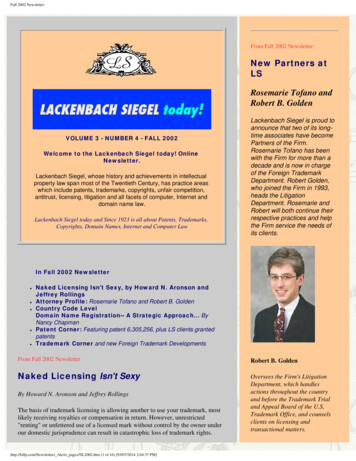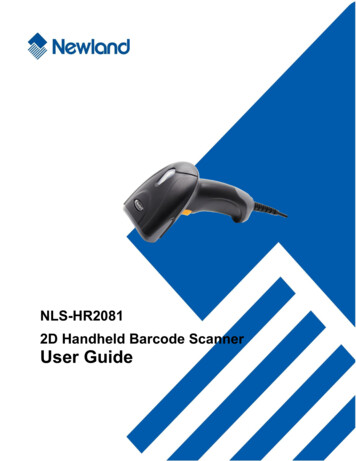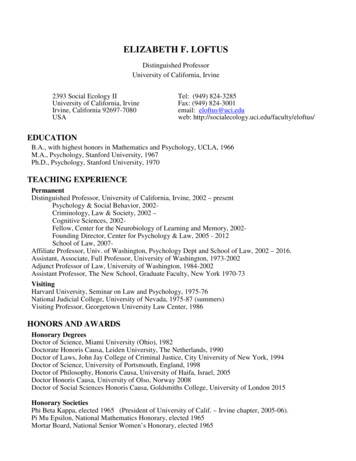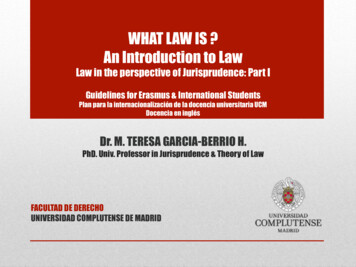
Transcription
Fall 2002 NewsletterFrom Fall 2002 NewsletterNew Partners atLSRosemarie Tofano andRobert B. GoldenVOLUME 3 - NUMBER 4 - FALL 2002Welcome to the Lackenbach Siegel today! OnlineNewsletter.Lackenbach Siegel, whose history and achievements in intellectualproperty law span most of the Twentieth Century, has practice areaswhich include patents, trademarks, copyrights, unfair competition,antitrust, licensing, litigation and all facets of computer, Internet anddomain name law.Lackenbach Siegel today and Since 1923 is all about Patents, Trademarks,Copyrights, Domain Names, Internet and Computer LawLackenbach Siegel is proud toannounce that two of its longtime associates have becomePartners of the Firm.Rosemarie Tofano has beenwith the Firm for more than adecade and is now in chargeof the Foreign TrademarkDepartment. Robert Golden,who joined the Firm in 1993,heads the LitigationDepartment. Rosemarie andRobert will both continue theirrespective practices and helpthe Firm service the needs ofits clients.In Fall 2002 Newsletter Naked Licensing Isn't Sexy, by Howard N. Aronson andJeffrey RollingsAttorney Profile: Rosemarie Tofano and Robert B. GoldenCountry Code LevelDomain Name Registration-- A Strategic Approach. ByNancy ChapmanPatent Corner: Featuring patent 6,305,256, plus LS clients grantedpatentsTrademark Corner and new Foreign Trademark DevelopmentsFrom Fall 2002 NewsletterNaked Licensing Isn't SexyBy Howard N. Aronson and Jeffrey RollingsThe basis of trademark licensing is allowing another to use your trademark, mostlikely receiving royalties or compensation in return. However, unrestricted"renting" or unfettered use of a licensed mark without control by the owner underour domestic jurisprudence can result in catastrophic loss of trademark rights.http://lsllp.com/Newsletters Alerts pages/NL2002.htm (1 of 16) [03/07/2014 2:04:37 PM]Robert B. GoldenOversees the Firm's LitigationDepartment, which handlesactions throughout the countryand before the Trademark Trialand Appeal Board of the U.S.Trademark Office, and counselsclients on licensing andtransactional matters.
Fall 2002 NewsletterWhile it is hornbook law that quality control is both contractually and in factpracticed in licensing situations, it is oftentimes forgotten that the penalty forbreaking the rules is loss of trademark rights in the licensed mark.Trademark licenses without verbiage allowing the licensor to practice qualitycontrol are styled Naked Licenses. They are "Naked" because they do not includethe necessary quality control language. For example, licenses typically requirelicensees to submit drawings, or prototypes of products to be marketed inconnection with the trademark licensed, and further require the licensee toperiodically submit production samples of such products. Licensors usually retainthe right to approve or disapprove of the quality of the overall product, its design,and the manner in which its trademark is used on, or in connection with theproduct. Licensees are forbidden from marketing products that have not beenapproved. Indeed, quality control provisions are valued so highly by licensors thatthese terms rarely become negotiated points in license contracts.A federal appellate court in Barcamerica IntÕl USA Trust v. Tyfield Importers,Inc. determined just this year that a trademark owner had abandoned itsLEONARDO DA VINCI trademark for wine by licensing the mark withoutincorporating quality control provisions in the license agreement, and withoutactually exercising any quality control.In the context of wine production, as the court noted, quality control could havebeen exercised by inspecting the facilities and procedures used to make the wine,and tasting and inspecting the final product to be sure that it was of a "quality"consistent with the licensorÕs vision of the trademark.Mr. Golden was admitted to thebar: 1993, New York; 1994, U.S.District Court, Southern andEastern Districts of New York;1998, U.S. Court of Appeals,Third Circuit; 1999, U.S. Court ofAppeals, Federal Circuit.Education: The GeorgeWashington University (B.A.1989); Brooklyn Law School (J.D.1992). Moot Court HonorSociety; DeanÕs Merit Scholar.Author and Lecturer: 1998 and1999 National CLE Conferences,Law Education Institute, Inc. &BNA Books, Inc., Trade Dress The Forgot-ten Trademark Rightand Trade Dress - The Product v.Packaging Tension; ContributingAuthor: "Protecting Designs byTrademark, Copyrights, andDesign Patents" Vol. 1, Ch. 3 inIntellectual Property Counselingand Litigation.and.Rosemarie TofanoBarcamerica IntÕl USA Trust was a trademark infringement suit filed by thetrademark owner licensor against an "infringing" producer and importer ofLEONARDO DA VINCI wines made in Italy. During the infringement trial, thelicensee testified that the licensor never exercised any "involvement whatsoeverregarding the quality of the wine and maintaining it at any level." While it wasargued the quality control existed by way of licensorÕs officers tasting a fewwines produced under the mark and relied upon the business reputation of itslicensee, the court found a lack of realistic quality control and rejected argumentsthat the final product was indeed acceptable. In affirming the lower courtÕs orderof Summary Judgment on the grounds of abandonment of the trademark, andcancellation of the licensorÕs Federal registration, the court found that thelicensor did not play "a meaningful role in holding the wine to a standard ofquality-good, bad, or otherwise."License agreements must be properly dressed to avoid nakedness, and a licensor,at least from time to time, must take a true commercial interest in the productsproduced under its mark. If not, licensors face the reality of abandonment andcancellation of their valuable trademarks.Country Code Level Domain NameRegistration-- A Strategic Approach.By Nancy Dwyer ChapmanThe growth of use of the Internet has been explosive, rising in twenty years fromvirtually nothing to 460 million in 2001. The number of users is increasing by 10http://lsllp.com/Newsletters Alerts pages/NL2002.htm (2 of 16) [03/07/2014 2:04:37 PM]Rosemarie TofanoResponsible for all overseastrademark Matters, includingsearching, filing, prosecution,maintenance, Opposition /Cancellation proceedings, andlicensing.Ms Tofano was admitted to bar,1991, Connecticut and NewYork. Education: FordhamUniversity (B.A., 1985); PaceUniversity (J.D., 1990); 1994, U.S. District Court, Southern and
Fall 2002 Newsletterto 20 million a year, with as many as 500 million users projected by 2003. The"rate of [its] adoption is much quicker than the rate of adoption of the telephoneor television," according to the World Intellectual Property Organization. Whilethe majority of those users have been in the US, the numbers of users in othercountries is steadily increasing, attesting to the global nature of the medium. July2001 statistics on home internet access from the Nielsen organization indicate:USA Ð 165.2 Million ("M), Germany Ð 27.9M, UKÐ 23.9M, Italy Ð18.7M,Taiwan Ð11.6M, Australia Ð 9.7M.Further evidence of the growing importance of non-US internet use isdemonstrated by NielsenÕs monitoring of Internet audience activity for Australia,Canada, Denmark, Finland, France, Germany, Hong Kong, Ireland, Italy, Japan,the Netherlands, New Zealand, Norway, Singapore, Sweden, and the UK. Despitethe current economic slowdown, e-commerce at the end of 2000 in Europe wasvalued at 17 billion euros and estimated to reach 340 billion euros by 2003.The cornerstone for establishing Internetpresence is the domain name, the www.name.com type of designation.Domain names are, or should be, concise and memorable, based upon companynames, trademarks, slogans, phrases and descriptive key words. The appropriatedomain name should ensure a userÕs quick access to oneÕs site, because the usermakes the obvious association between the domain name and the putative source.The user types in "generalelectric.com" or "ge.com" and brings up the home pagefor the General Electric Company. A domain name that conveys that readyconnection is a valuable asset to an enterprise and is now recognized as acomponent of a companyÕs intellectual property portfolio.Because domain names have assumed this important role, the creation of aninternational, strategic domain name development and registration program is animportant component of any overall business plan. Legal counsel needs to take aleadership role in advising its client of the benefits of implementing such aprogram, the costs to be incurred, and in providing on-going guidance andmanagement of domain names as business assets.BACKGROUND OF THE DOMAIN NAME SYSTEMEastern Districts of New York,1994, Court of Appeals for theFederal Circuit, and 1994, U.S.Supreme Court. Member: NewYork State and American BarAssociations. Co-Author, "HowNot to Incorporate," New YorkState Bar Journal, July 1988; CoAuthor: "Global Colorblindness toTrademarks is Dying," TheNational Law Journal, June 5,1995.The U.S.Trademark OfficeSpeaksThe U.S. TrademarkOffice announced thattrademark applicationsfor the next two-and-ahalf years will be belowthe figure for 2001 andthe projected figure for2002:ÒIn 2002 we project that therewill be 260,000 applicationsand in 2004 we project286,000 applications. To giveyou some perspective on this,in 2001 when we had 290,000applications we had to detailover 90 trade mark attorneysto other jobs in the agencybecause there was not enoughwork for themÉ Ourprojections for 2003 and 2004fully support the fact that thereis not enough work in trademark operations to justify thesize of our trademark attorneyworkforce.ÓPATENT CORNERFeaturing a recently issued patent toa client of Lackenback SiegelUnited States Patent Number:The Internet began in the late 1960s as a network of four universitiesÕ computershttp://lsllp.com/Newsletters Alerts pages/NL2002.htm (3 of 16) [03/07/2014 2:04:37 PM]
Fall 2002 Newsletterknown the ARPANET which grew into the Internet, a group of multipleindependent networks with encompassing satellite networks, and mostimportantly, having an "open architecture" which allowed a provider ofconnections choices in network technology. The advantages of this nascentcommunications system proved appealing to an expanding community ofresearchers and developers and the US Department of Defense who also began tocommunicate via electronic mail, demonstrating its potential versatility and scope.By the early to mid 1990s, the World Wide Web became a commercial realitywith programming language innovations enabling easier functioning of theInternet and millions of computer hosts online. The Domain Name System (DNS)was created in the early 1980s.6,305,256Date of Patent:October 23, 2001Inventors:Wayne Anderson andPaolo CassuttiWHY ccTLDs?What is becoming increasingly clear to many companies is that obtaining a "dotcom" domain name does not mean all bases have been covered, particularly giventhe growing numbers of Internet users throughout the world. Over 36,000,000domain names have been registered worldwide, with two-thirds of those beingÔdot-coms.Õ Of the country code domains, the largest numbers of registrationsare in the UK, Canada, Germany, Korea and the Netherlands. It follows that aprudent and thorough domain name policy must consider the benefits andopportunities that can be reaped from registering appropriate individual countrycode "Top Level Domain" names ("ccTLD"). As Audrey Apfel of the GartnerGroup stated, "Being in Ôdot-comÕ does not mean you are Ôdot-done.ÕÉObtaining appropriate ccTLD protection makes good economic and businesssense when considering the needs and sensibilities of an international user andcustomer population. While US-centric Internet users may automatically think"dot-com," a British user thinks and researches in a "dot-uk (.uk)" frame of mind.Italian users are known to look for .it domains first when on the Internet.International users will look for local content in their local language andbookmark these sites. Just as marketers must tailor their products and services tolocal needs and tastes, so should they consider the benefits of similarly targetingwebsites and their addresses by way of domain names to foreign Internet users.Note, for example, that Internet portal Yahoo! now offers the following "LocalYahooÕs" in Europe: Denmark, France, Germany, Italy, Norway, Spain, Sweden,and UK & Ireland; in Asia Pacific: Australia & New Zealand, China, Hong Kong,India, Japan, Korea, Singapore and Taiwan, and in the Americas: Canada,Argentina, Brazil and Mexico. At least a portion of these sites is accessible byusing the ccTLD yahoo.dk, .de, or .ca, etc. URL.Nortel Networks commenced its ccTLD registration program as its countrymanagers began requesting ccTLDs for marketing purposes, even without theestablishment of a concomitant local website. NortelÕs Web InternationalizationManager Maria Manzo says that Nortel found that the country level domain namewas being keyed in first at overseas operations, so the company realized it had toobtain the corresponding ccTLDs to meet this globalization need. Nortel hasdeveloped 52 country sites with local content in thirteen different languages andhas around 109 ccTLD registrations based on the "nortelnetworks" secondarylevel domain. Use of a ccTLD helps to make the Internet experience seem closerto home for the user, encouraging loyalty and satisfaction. "[S]ensitivity tocultural and national distinctions will separate success from failure" in the onlinemarketplace, noted Jim Rose, CEO of QXL.com, an online auction servicetargeting Europe. An enterpriseÕs ccTLD sites can emphasize local content, locallanguage and play upon local preferences. It can also help an enterprise market toa particular region. Rick McMurtry, IP counsel for Turner Broadcasting System,http://lsllp.com/Newsletters Alerts pages/NL2002.htm (4 of 16) [03/07/2014 2:04:37 PM]COMPLETE HAND TOOLSET IN ONE HAND TOOLThis invention in one broadaspect is a single hand tool whichoperably contains a completescrewdriver or multiple tool bitdrive hand tool set. In anotheraspect, this invention is one handtool which integrally containsupwards of 26 different tool bitdrives in combination withmultiple hex nut drives, whichtool bit drives and hex nut drivesare readily interchangeably usedin the one hand tool.The hand tool of the present
Fall 2002 Newsletternotes that TBS, for example, uses Latin American ccTLDs to focus segments ofits online offerings for local programming and test marketing for productionshorts for that sector of the world in particular. They find ccTLDs can target theirentertainment and news products to specific markets. Search engines havecustomized their services to target country-specific content and, by use of theappropriate ccTLD, reinforce the local focus. "Because of the localizationpreference, most foreign residents use search engines that correspond to theappropriate ccTLD.invention provides an ergonomichandle design to house amaximized number of tool bitdrives and hex nut drives. Thehandle in combination with aremovable multiple tool bit driveshank provides a full complementof tool bit drives.Unfortunately for most U.S. corporations, these search engines present an initialforeign market barrier by filtering the search results by language and prioritizingby local country code. Therefore, .com domain names are not included in theirsearch results." ccTLDs can also play an important role in establishing andreinforcing uniform branding for an enterprise and can provide, as appropriate,intellectual property protection against brand and trade name pirates and againstunwanted anticompetitive activity. A 1998 survey conducted by MARQUES, aEuropean association of corporate trademark owners and intellectual property lawfirms and related providers, provided a telling snapshot of intellectual propertyvulnerability on the Internet. 60 respondents from 24 countries reported thefollowing online experiences: 85% suffered infringement of their intellectualproperty.The present invention provides aclear plastic ergonomic handlewhich permits ready viewing ofand access to the tool bit driveswithin the handle. The tool bitsmay be color coded as to bothsize and function for viewingthrough the clear plastic handlefor ready identification andaccess.78% experienced domain name infringement.98% felt the issue of protection of names on theInternet was very important.80% wanted controls restricting nationalregistration authorities from marketing ccTLDsinappropriately.In commenting on the survey results, the then-Chairman of MARQUES,Christopher Devereux, stated, "Trade mark owners are very concerned aboutInternet infringement. This is not just an issue for large companies but for thepublic who must have confidence that they can connect on the Internet with theparty they are looking for." In fact, one major US corporation which has asignificant and growing international presence in both traditional venues and onthe Internet has developed the following credo in pursuing ccTLDs: "We get itnow or pay for it later."That shrewd assessment comes from Turner Broadcasting which has pursued anactive ccTLD registration initiative in some 150 ccTLD registries. RickMcMurtry, TBS IP counsel, manages and coordinates his companyÕs domainname registration program and decides whether to file based on present andforeseeable-future needs and network presence, now and in the pipeline. Hefactors in the requests of the companyÕs marketing managers, the likelihood ofdomain name piracy, the costs for filing and the ease or difficulty in meeting theparticular ccTLDÕs registration requirements.ccTLDs ARE NOT ALL ALIKEThere are over 240 ccTLDs, from .ac for Ascension Islandto .zw for Zimbabwe. See http://www.iana.org/cctld/cctldwhois.htm for the complete list. However, less than 200 arehttp://lsllp.com/Newsletters Alerts pages/NL2002.htm (5 of 16) [03/07/2014 2:04:37 PM]The hand tool of the presentinvention is essentially acomplete tool set to the user. Thehand tool is of practical and safedesign and construction, andreadily manufactured by meansknown to those skilled in the art.Patent CornerDigest:Notable, recent LS Patentssecured by: Henry Marzullo,Jr., Myron Greenspan andMarvin Feldman.INTERLEAVER FOR PARALLEL8 BIT CELL OF ATM SYSTEMSAND A METHOD THEREFORPatent No.: 6,449,277 Assignee:Hyundai Electronics Industries,Co., Ltd. (Republic of Korea)AUTOMATIC PRODUCTWEIGHING MACHINES,PARTICULARLY FOR FOODPRODUCTS Patent No.:6,448,511 Assignee: TalleresDaumer, S.A. (Spain)WORKPIECE MOUNTING FORA WORKING MACHINE PatentNo.: 6,446,949 Assignee: HaasLaser GmbH & Co. KG,(Germany) ROLLER SKATEAND WHEEL FOR USE ON
Fall 2002 Newslettercurrently active, and of these, there are subsets thatoperate only fitfully. It must be noted that relative to thenumber of dot-com domain names registered - over 22million - the numbers of domain name registrations at theccTLD level are but a fraction. Moreover, the vast majorityhave registered few domains.The countries with the most registration activity include Argentina, Austria,Belgium, Canada, China, the Czech Republic, Denmark, France, Germany, Italy,Japan, Korea, the Netherlands, Norway and the UK which have each registeredover 100,000; of those, only Argentina, Brazil, Canada, Denmark, Germany, Italy,Japan, Korea, the Netherlands and the UK have over 200,000 apiece.At present there is no uniformity in the rules governing the registration of ccTLDdomain names from country to country, and these existing rules are mostdefinitely subject to change. Fortunately, the general trend of this change istoward a simplification of requirements and an opening of registrationopportunities to more applicants rather than skewing the process in favor ofdomestic entities. There are three broad categories of ccTLD countries:unrestricted, restricted and semi-restricted.There are approximately 86 ccTLDs which are unrestricted with additional subdomains like .co.uk (as opposed to the top level .uk). A number of countriesrequire an applicant to further qualify its domain by adding a secondary domain toindicate the registrant is a corporate entity or an academic institution, for example.Unrestricted countries do not require that the applicant have a local presence;that registry is open to any and all applicants. There is no limitation on thenumber of domain name registrations a single party may obtain, and registrationsare issued on a first-come, first-served basis.Restricted countries have registration requirements that were designed to givepreference to local entities. They require the applicant to have a local presence byway of a local company, a local (national) trademark registration, a local taxidentification number, a local billing or administrative contact, and even in somecases, a local domain name server. The local presence requirement in some casesmandates the presence of an in-place corporate entity, as, for example, in Monacoand Macao.Other countriesÕ presence requirement is satisfied by the designation of a localrepresentative or proof of registration upon the registry of businesses or itsequivalent. In Canada the local presence requirement is satisfied by proof of alocal trademark registration. In some countries a local contact must be given, anda local law firm may suffice in some cases. Many restricted countries further limitregistration to one domain name per organization, a practice that obviously forcesthe choice to be oneÕs business name or most important trademark only.Semi-restricted countries also require a local presence of some sort but imposeno limit on the number of domain name registrations a party may own. Where thedomain name does not consist of a company name, restricted and semi-restrictedcountries may require the applicant to submit proof of ownership of a localtrademark registration or pending application for the word(s) comprising thedomain name. Where trademark rights are required, the domain name and thetrademark most often must be identical. By way of illustration of the variety ofregistration schemes, note the following breakdown in Europe. The unrestrictedhttp://lsllp.com/Newsletters Alerts pages/NL2002.htm (6 of 16) [03/07/2014 2:04:37 PM]SUCH A ROLLER SKATE PatentNo.: 6,443,463 Assignee: MarkHandels, AG (Switzerland)MACHINING PROCESSORPatent No.: 6,438,445 Assignee:Makino Milling Machine Co., Ltd.(Japan) COMPACT OR MINIDISC Patent No.: D6,461,819Assignee: Shape CD Ltd. (USA)MONOCLONAL ANTIIDIOTYPIC ANTIBODIES (AB2)AND THEIR USES Patent No.:6,433,148 Assignee: Centro deImmunologia Molecular (Cuba)COLLAPSIBLE/PORTABLESOCCER GOAL Patent No.:6,432,002 Assignee: Inventor:Onofrio F. Pavonetti (USA)SAFETY VALVE FOR FLUIDSPatent No.: 6,431,520 Assignee:VALVULAS ARCO. S.A. (Spain)SYSTEM FOR FASTENINGBATHROOM ACCESSORIESPatent No.: 6,430,759 Assignee:Ibergesfer, S.L., (Spain)ASYNCHRONOUS TRANSFERMODE (ATM) CELLMULTIPLEXING /DEMULTIPLEXINGAPPARATUS Patent No.:6,430,197 Assignee: HyundaiElectronics Inds. Co., Ltd.,(Republic of Korea) AUTOMATICWHITE BALANCEADJUSTMENT SYSTEM PatentNo.: 6,429,905 Assignee: FunaiElectric Co., Ltd. (Japan)SPINDLE MOTOR WITHMAGNETIC SEAL Patent No.:6,429,560 Assignee: PrecisionMotors Deutsche Minebea GmbH(Germany) MONOCLONALANTIBODY WHICHRECOGNIZES THEOLIGOSACCHARIDE NGLYCOLYLATED-GALACTOSEGLUCOSE SIALIC ACID INMALIGNANT TUMORE, ANDCOMPOSTION CONTAINING ITPatent No.: 6,429,295 Assignee:Centro de Inmunologia Molecular(CIM) (Cuba) BEAN BAG SHOELOWER Patent No.: D460,852Assignee: CandieÕs, Inc. (USA)METHOD FOR WIRELESSAND REMOTETRANSMISSION ANDRECEPTION OF CODEDINFORMATION,VARIANTS AND
Fall 2002 Newslettercountries are Austria, Belgium, Denmark, Switzerland, and the UK. The restrictedor semi-restricted countries are Finland, France, Germany, Greece, Ireland, Italy,Hungary, Luxembourg, the Netherlands, Portugal, Spain, Sweden, with Franceand Sweden having sub-domains with easier terms for registration of domainsbased on trademarks. Trademark owners in those countries can file for ".tm.fr" or".tm.se" domain names. A few ccTLDs are being manipulated to act as Ôotherthan as a country name abbreviation. One of the better marketing success storiesfor these "general purpose domains" concerns .tv which is run by the .TVCorporation International (DotTV) under an agreement with the government ofTuvalu which owns the domain. Both Bloomberg and TBS have obtained .tvccTLD registrations for key names in view of their companiesÕ presences intelevision media. DotTV has guaranteed a minimum payment of 1 million perquarter to Tuvalu; selling .tv domains for general use for television-related sites,goods and services has become the islandÕs largest source of revenue. Similarefforts have been launched for .sr (Suriname) as a domain and e-mail address for"senors, seniors and signores," .co (Colombia) as an alternate to .com, .cc (CocosIslands) as another alternate to .com, .ws (Western Samoa) as a description forÔworldsite,Õ and the recently announced intention to market .bz (Belize) as a sitefor business. Counsel and client should evaluate the efficacy and need forprotection in these specialized domains and take note that many of these chargevery hefty fees for registration. In fact, .tv auctions its domains rather than sellsthem for a set price Ð a potential budget breaker.CRAFTING A ccTLD STRATEGYFour and a half years ago an analytical article on trademarks on the Internet in theElectronic Commerce & Law Report carried the summary header reading: "If newInternet domain name space is created, trademark owners will be faced with adifficult decision. Should they register in any or all of the new domains in order toprotect their trademarks, or trust their marks to the courts and global disputeresolution processes?" The question is as pertinent today as it was in early 1998,and arguably, with the continued growth of the Internet especially outside theUnited States, a domain name registration strategy is ever more important.However, some companies are behind the registration curve, especially inEuropeÕs Internet business community, according to Landwell, the legal offshootof PricewaterhouseCoopers. In a recent survey of nearly 200 dot-com managersand CEOs in France, Germany, the Netherlands and the UK only 42% hadprotected their trademarks and domain names in overseas jurisdictions where theirwebsites could be accessed, putting some of those enterprisesÕ most valuableassets Ð their intellectual property Ð at risk. This conclusion is reinforced by asurvey conducted by Net Searchers at the 2001 International TrademarkAssociation Annual Meeting, finding that more than half of intellectual propertyspecialists, both in-house and in law firms, do not have a strategy for registeringdomain names worldwide.PRODUCT DESIGN - PROTECTION 101By Myron GreenspanThe Problem:When non-functional elements of a product design are copied or emulated therehttp://lsllp.com/Newsletters Alerts pages/NL2002.htm (7 of 16) [03/07/2014 2:04:37 PM]PORTABLE DEVICE FORREALISING THISMETHODPatent No.: 6,424,819Assignee: Cybiko, Inc. (USA)NON-IMAGING LIGHT SOURCEFOR UNIFORM ILLUMINATIONAPPLICATIONS Patent No.:6,422,718 Assignee: IntegratedSystems Technologies Ltd.(United Kingdom)APPARATUS FORMEASURING INPUT ANDOUTPUT LEVELS OFBASE STATIONTRANSMITTERS IN AMOBILE COMMUNICATION SYSTEMPatent No.: 6,421,332Assignee: Hyundai ElectronicsInc. Co., Ltd., (Republic ofKorea)PREOCESS FOR THEPREPARATION OF STABLEYEAST CRYSTALS FORENHANCED PRODUCTION OFETHANOL Patent No.: 6,420,146Assignee: Council of Scientific &Industrial Research (India)PINCH ROLLER BEARINGSTRUCTURE FOR MAGNETICTAPE APPARATUS Patent No.:6,419,139 Assignee: FunaiElectric Co., Ltd. (Japan)ARYLPIPERAZINYLALKYL-3(2H)-PYRIDAZINONES Patent No.:6,413,966 Assignee: FAES,Fabrica Espanola de ProductiosQuimicos y Farmaceuticos, S.A.
Fall 2002 Newsletterare a limited number of tools in the armamentarium of enforceable rights to stop acompetitor. While aesthetic elements may be protectable by copyrights, these aretypically protectable only if the elements are works of art that can be separatedfrom and can exist apart from the product itself. Certain product design arespecifically excluded from protection by copyright. In the past there has beenreliance on the branches of unfair competition dealing with trademarks and tradedress for stopping competitors, whenever the productÕs appearance wasinherently distinctive or unique or had acquired secondary meaning in the marketplace. In those instances, the principles of trademark law were frequentlysuccessfully invoked to protect the public from a likelihood of confusion, sincethe public associated the non-functional design with a specific source or theoriginal provider of the product. However, the U.S. Supreme Court has noweffectively ruled out trade dress protection for most product designs.Therefore, unless a design patent was timely filed protection for the aestheticdesign elements may be lost.(Spain)DIGITAL LIGHTPROTECTIONAPPARATUS WITHDIGITAL MICROMIRRORDEVICE ANDROTATABLE HOUSINGPatent No.: 6,412,972Assignee: Altman StageLighting Co. (USA)An Answer:Filing a design patent application irrespective of whether there is patentability inthe functional aspects of the product design.1.No need to rely on trade dress protection, at least initially. Patents affordrelatively early protection, without the need to spend substantialadvertising dollars.2.If an infringing product is introduced before a design patent issues, petitionmay be filed in USPTO to expedite prosecution and issuance of designpatent.3.Design patents are provided for by the Patent Act, Title 35, U.S. Code, andpremised on Article I, Section 8 of the U.S. Constitution. The Protection isstatutory.4.Damages are well defined, and provisions exist for treble damages andattorney fees, in instances of willful infringement.5.Protection is defined by a great body of decisional law, and madesubstantially uniform throughout the count
Fall 2002 Newsletter VOLUME 3 - NUMBER 4 - FALL 2002 Welcome to the Lackenbach Siegel today! Online Newsletter. Lackenbach Siegel, whose history and achievements in intellectual










